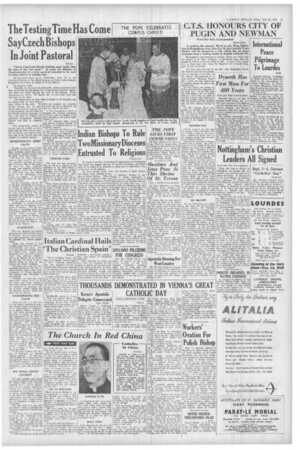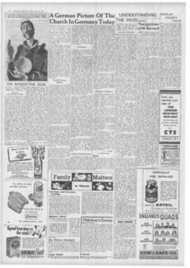Page 5, 24th June 1949
Page 5

Report an error
Noticed an error on this page?If you've noticed an error in this article please click here to report it.
Tags
Share
Related articles
°scott Prepares For Big Rally
Newman's First Birmingham Church Was Bombed
Pugin And 'the Millionaire Saint'
'newman Meets In Cardinal's City
`antient & Majestic'
C.T.S. HONOURS CITY OF
PUGIN AND NEWMAN From Our Own Correspondent
BIRMINGHAM.
tion in Birmingham from July 5 to 16, the Catholic Truth Society will be honouring a city which has on many occasions been a leading centre in English Catholic life.
Birmingham's post-reformation Catholic history may begin with the Church of St. Mary Magdalen, in Masshouse Lane, near the present Sts Peter's, which was built in 1687. It cost f1,300, a large sum in those days, and James II, England's last Catholic King, gave 25 tons of timber.
Rev, John Randolph, O.F.M. The first stone was laid by the The Church stood for two months after its opening; it was then, on the King's fall, destroyed by a mob, on that " Running Thursday " which saw the destruction of Catholic chapels throughout the Midland area.
The next church, the present St. Peter's, came after the suspension of the penal laws. Yet in 1784 there were still dangers, and the church, built in a back street, was made to look like a factory with windows too high for popular violence to break. The mob burnt down the Unitarian Old and New Meeting Houses in 1791.
The New Meeting House later passed into Catholic hands. and is the present St. Michael's Church, the centre for the Poles in the city. The year 1813 saw a second Catholic chapel in Shadwell Street, the predecessor of the present St. Chad's Cathedral.
PROGRESS FAST Catholic progress was fast after the opening of the 19th century; Oscott College carried on the educational tradition of Douai, and was the residence of the Vicar Apostolic of the Midland District.
'Pugin beeame Professor of ECCICSIastical Art at Oscott, and had a large part in the design of the new College; the chapel was in 1838 dedicated with a splendour of ritual hitherto unknown in Catholic England: and in 1839 a legacy enabled Bishop Walsh to embark on the building of St. Chad's Cathedral.
Pugin was the architect, and in a Gothic building with a Rood Screen as its main feature he set out to show what a pre-reformation church
really was. Splendidly furnished, thanks to the munificence of the Hardman family, the Birmingham firm of Church Furnishers, with 15th century pulpit and lectern from Louvain, choir stalls from S. Maria in Capitolio, in Cologne, and images from suppressed continental abbeys. St. Chad's was worthy of elevation to the dignity of a Minor Basilica —Se Chad's was worthy of the occasion when on October 27, 1850, William Bernard Ullathorne was enthroned there as first Bishop of Birmingham.
THE ORATORY
The year 1849 brings a new figure on the scene, the newly-ordained Oxford convert, Dr. Newman, founding his Oratory in disused factory buildings in Alcester Street. In the outburst against "Papal Aggression " in the following year Newman founded the Little Oratory as a means of organising lay Catholics, and delivered his lectures in the Corn Exchange, showing up Protes
tant prejudice. It was Newman who preached at the first Provincial Synod of Westminster at Oscott his sermon on "The Second Spring." The Oratory in 1852 was moved to Edgbaston—the capacious cellars on the sloping ground were thought to be dungeons without which no religious house could be complete.
It was there that Newman wrote those works which have made him the best-known figure in Catholic thought in modern times, and which have made Birmingham and its Oratory a place of pilgrimage to Catholics from all parts of the world. The Oratory Church, Newman's memorial, built in the Italian style which he loved, stands over against Gothic St. Chad's to symbolise, not this time the restoration of a pre-reformation splendour, but the universal tradition of Western Christendom, centred on Rome, whence flow Peter's blessings orbi et orbi.
blog comments powered by Disqus









